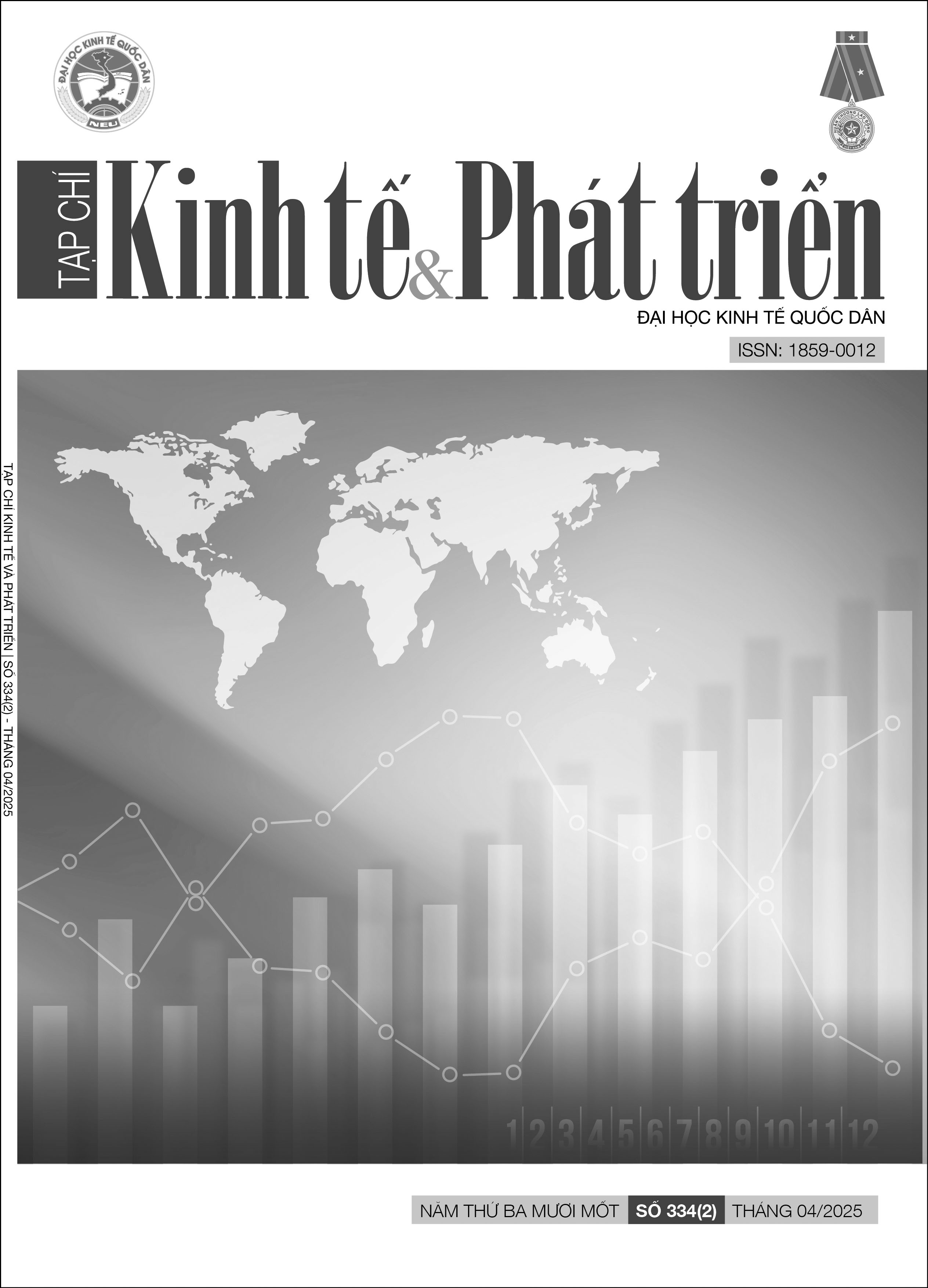Tác động của tài chính toàn diện kỹ thuật số đến an toàn vĩ mô: Xem xét vai trò của chỉ số phát triển công nghệ thông tin và truyền thông
DOI:
https://doi.org/10.33301/JED.VI.2255Từ khóa:
Tài chính toàn diện kỹ thuật số, chỉ số phát triển công nghệ thông tin và truyền thông, an toàn vĩ môTóm tắt
Bài báo nghiên cứu tác động của tài chính toàn diện kỹ thuật số đến an toàn vĩ mô khi xem xét vai trò của chỉ số phát triển công nghệ thông tin và truyền thông (IDI) trong giai đoạn 2010-2022 với dữ liệu của 57 quốc gia. Bằng phương pháp hồi quy Bayes, kết quả nghiên cứu cho thấy tài chính toàn diện kỹ thuật số có tác động tiêu cực đến an toàn vĩ mô với xác suất xảy ra tác động tiêu cực là 87,74 % và khi chỉ số IDI càng cao thì mức độ tác động tiêu cực này càng tăng với xác suất xảy ra là 100%. Điều này hàm ý rằng các quốc gia cần có chính sách thúc đẩy tài chính toàn diện với việc áp dụng kỹ thuật số hợp lý để vừa giúp các đối tượng khó khăn có thể tiếp cận được các dịch vụ tài chính kỹ thuật số nhưng vẫn đảm bảo mức độ an toàn vĩ mô cho các quốc gia hay nói cách khác hạn chế tác động tiêu cực của tài chính toàn diện kỹ thuật số đến an toàn vĩ mô ở mức thấp nhất.
Tài liệu tham khảo
Allen, F. & Gale, D. (2000), ‘Financial contagion’, Journal of political economy, 108(1), 1-33.
Anton, S. & Nucu, A.A.E. (2024), ‘The impact of digital finance and financial inclusion on banking stability: International evidence’, Oeconomia Copernicana, 15(2), 563-593.
Bhattacharyay, B.N. (2003), Towards a macro-prudential leading indicators framework for monitoring financial vulnerability’, CESifo Working Paper No. 1015, CESifo.
Chinoda, T. & Kapingura, F.M. (2023), ‘The impact of digital financial inclusion and bank competition on bank stability in sub-Saharan Africa’, Economies, 11(1), 15-27. https://doi.org/10.3390/economies11010015
Coase, R.H. (1937), ‘The nature of the firm’, Economica, 4(16), 386-405.
https://doi.org/10.1111/j.1468-0335.1937.tb00002.x
Demirgüç-Kunt, A., Klapper, L., Singer, D., Ansar, S. & Hess, J. (2020), ‘The global findex database 2017: Measuring financial inclusion and opportunities to expand access to and use of financial services’, The World Bank Economic Review, 34, S2-S8. https://doi.org/10.1093/wber/lhz013
Evans, O., Leone, A.M., Gill, M. & Hilbers, P. (2000), ‘Macroprudential indicators of financial system soundness’, IMF Occasional Paper No. 192, International Monetary Fund.
Gelman, A. & Rubin, D.B. (1992), ‘Inference from iterative simulation using multiple sequences’, Statistical Science, 7, 457-472. https://doi.org/10.1214/ss/1177011136
Khera, P., Ogawa, M.S. & Sahay, M.R. (2021), Is digital financial inclusion unlocking growth?, International Monetary Fund.
Lapukeni, A.F. (2015), ‘The impact of financial inclusion on monetary policy effectiveness: The case of Malawi’, International Journal of Monetary Economics and Finance, 8(4), 360-384. https://doi.org/10.1504/IJMEF.2015.073229
Minsky, H.P. (1986), ‘Stabilizing an unstable economy’, Hyman P. Minsky Archive, 144. https://digitalcommons.bard.edu/hm_archive/144
Mörttinen, L., Poloni, P., Sandars, P. & Vesala, J. (2005), ‘Analysing banking sector conditions: How to use macro-prudential indicators’, ECB Occasional Paper No.26, European Central Bank.
Ogbuabor, J.E., Eigbiremolen, G.S.O., Orji, A., Manasseh, C.O. & Onuigbo, F.N. (2020), ‘ICT and financial inclusion in Nigeria: An overview of current challenges and policy options’, Nigerian Journal of Banking and Finance, 12(1), 90-96.
Ozturk, I. & Ullah, S. (2022), ‘Does digital financial inclusion matter for economic growth and environmental sustainability in OBRI economies? An empirical analysis’, Resources, Conservation and Recycling, 185, 106489. https://doi.org/10.1016/j.resconrec.2022.106489
Risman, A., Mulyana, B., Silvatika, B. & Sulaeman, A. (2021), ‘The effect of digital finance on financial stability’, Management Science Letters, 11(7), 1979-1984. https://doi.org/10.5267/j.msl.2021.3.012
Sajid, M., Ansari, M.A.A., Farooq, F. & Faheem, M. (2024), ‘Sustaining and stabilizing during Covid-19: Effective management of bank financial behavior through digital financial inclusion’, Pakistan Journal of Humanities and Social Sciences, 12(2), 1016-1027. https://doi.org/10.52131/pjhss.2024.v12i2.2156
Suhrab, M., Chen, P. & Ullah, A. (2024), ‘Digital financial inclusion and income inequality nexus: Can technology innovation and infrastructure development help in achieving sustainable development goals?’, Technology in Society, 76, 102411. https://doi.org/10.1016/j.techsoc.2023.102411
Sun, Y. & Tang, X. (2022), ‘The impact of digital inclusive finance on sustainable economic growth in China’, Finance Research Letters, 50, 103234. https://doi.org/10.1016/j.frl.2022.103234
Syed, A.A., Özen, E. & Kamal, M.A. (2022), ‘Do digital financial services influence banking stability and efficiency: an ARDL analysis of a developed and a developing economy’, in The New Digital Era: Digitalisation, Emerging Risks and Opportunities, Emerald Publishing Limited, 13-30. https://doi.org/10.1108/S1569-37592022000109A002
Tao, Z., Wang, X., Li, J. & Wei, X. (2023), ‘How can digital financial inclusion reduces relative poverty? An empirical analysis based on China household finance survey’, Finance Research Letters, 58, 104570. https://doi.org/10.1016/j.frl.2023.104570
Williamson, O.E. (1981), ‘The economics of organization: The transaction cost approach’, American Journal of Sociology, 87(3), 548-577.
https://doi.org/10.1086/227496
Wolken, T. (2013), ‘Measuring systemic risk: The role of macro-prudential indicators’, Reserve Bank of New Zealand Bulletin, 76(4), 13-30.
World Bank (2017), Global Financial Development Report 2017: Financial Inclusion, Washington, DC.





